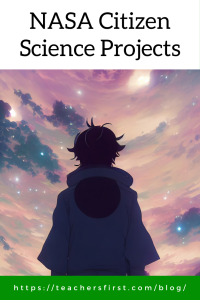July 20 marks Space Exploration Day, which celebrates the anniversary of the first crewed mission to the Moon in 1969. The study and exploration of space give us the unique opportunity to foster curiosity and instill a sense of wonder in our students. In addition to traditional learning opportunities, citizen science projects offer a collaborative approach for students to actively participate in scientific research while contributing to real-world science projects.
Citizen science involves individuals or groups of amateur scientists collaborating with researchers to collect, analyze, and interpret data. It combines professional scientists’ expertise with ordinary people’s enthusiasm and dedication. Citizen science projects allow students to develop essential scientific skills, enhance their understanding of complex concepts, and experience the thrill of contributing to fundamental scientific discoveries.
NASA has been at the forefront of innovation and engagement. The agency recognizes the value of involving the public in its scientific endeavors and, as a result, has developed numerous citizen science projects that invite students to become active participants in space exploration. NASA’s Citizen Science website shares many opportunities for everyday citizens to participate in projects that include solar system studies, the sun and earth, and space experiments.
Below are some examples of citizen science opportunities for students available on the NASA website:
- Globe Observer:
- Students contribute to NASA’s Earth science research by observing and collecting data on various environmental factors, such as clouds, land cover, and mosquito habitats. These observations help scientists improve their understanding of our planet’s ever-changing systems and develop strategies to address environmental challenges.
- Planet Hunters TESS:
- Join the search for exoplanets using data from NASA’s Transiting Exoplanet Survey Satellite (TESS). Students analyze light curves and identify potential planetary transits, enabling them to make valuable contributions to the discovery and characterization of exoplanets.
- NASA’s Asteroid Data Hunter:
- Analyze images that NASA’s NEOWISE mission captured to detect and track near-Earth asteroids. By identifying these celestial objects, students play a crucial role in safeguarding our planet and advancing our understanding of the solar system.
- Moon Mappers:
- Students explore the Moon’s surface with the assistance of the Lunar Reconnaissance Orbiter (LRO). By mapping craters and other lunar features, students contribute to creating detailed maps that aid in planning future human missions and scientific investigations.
Integrating citizen science into the classroom provides students with an authentic context for learning, encourages critical thinking and problem-solving skills, fosters a sense of ownership and responsibility, and nurtures a passion for scientific inquiry. Consider using these methods and resources to implement citizen science projects:
- Project-Based Learning: Design project-based activities that align with citizen science projects. Allow students to take ownership of their learning by setting research goals, collecting data, and analyzing results.
- This special topics collection shares many resources for project-based learning activities for all grade levels.
- Learn more about project-based learning by viewing the archive of this Twitter chat.
- Collaborative Learning: Encourage collaboration and teamwork by organizing students into groups to work on citizen science projects. This promotes communication skills, cooperation, and the ability to work effectively in diverse teams.
- Learn about three cool tools to amp up collaboration by watching this archive of an OK2Ask webinar.
- Visit TeachersFirst Edge – Curating to find tools for curating and sharing information with community members.
- Community Engagement: Foster a sense of community engagement by involving students in local citizen science initiatives and encouraging them to share their findings with their community. This helps students understand the broader implications of their work and its potential to make a real-world impact.
- Contact your local tv weather person and community colleges as a resource for finding local groups that are involved with space-related citizen science projects. Weather people and meteorologists often have contact with astronomy groups and educators.
- Find tools for curating and sharing information with community members on TeachersFirst Edge.
Citizen science allows students to actively participate in scientific research while immersing themselves in the wonders of space exploration. Taking advantage of NASA’s citizen science projects provides many opportunities to engage and inspire students through real-world learning situations. Who knows, one of your students might discover the next big breakthrough in space science!


